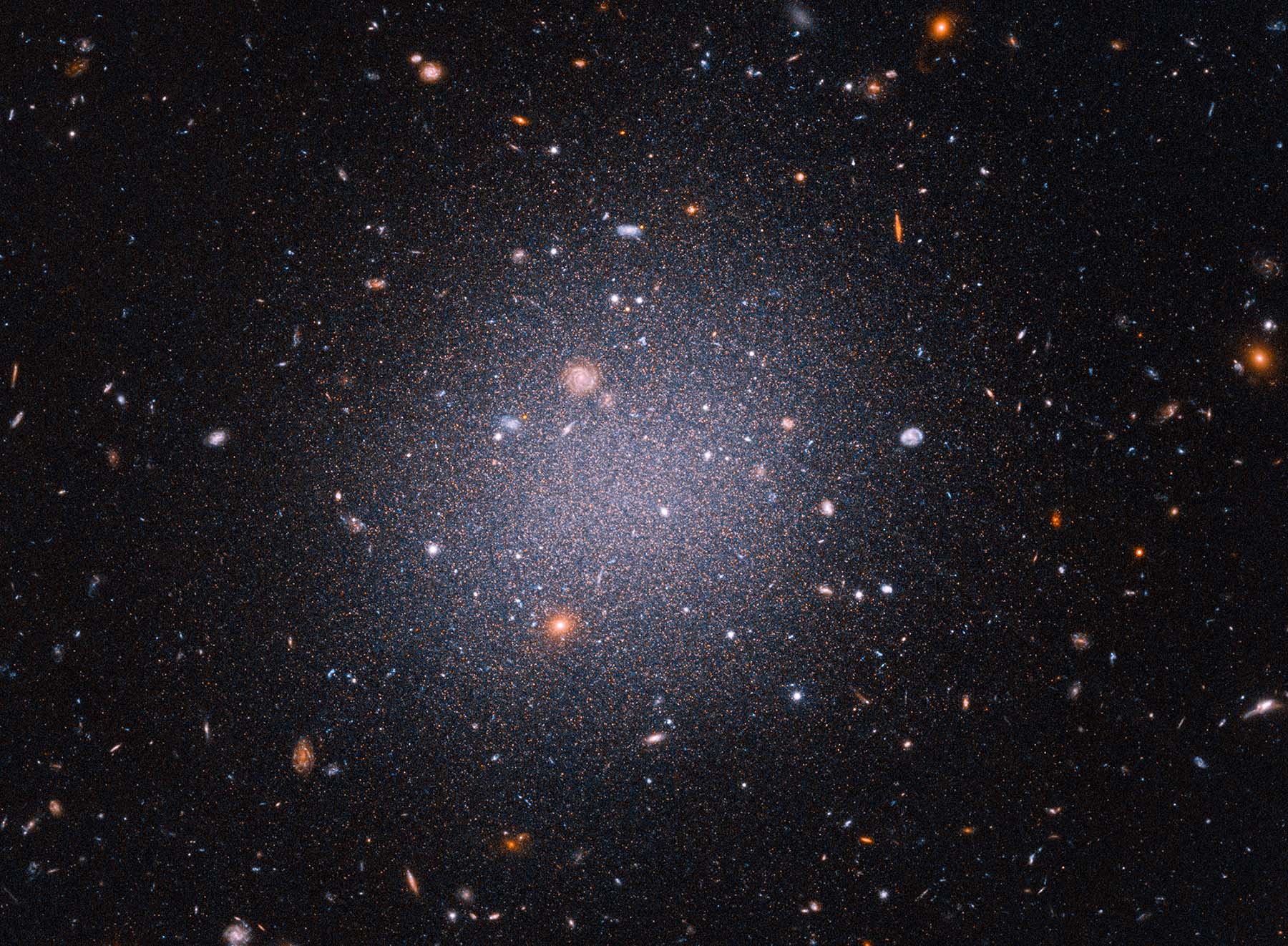STScI: Mystery of Galaxy’s Missing Dark Matter Deepens

This Hubble Space Telescope snapshot reveals an unusual galaxy that researchers call a “see-through galaxy.” The giant cosmic cotton ball is so diffuse and its ancient stars are so spread out that distant galaxies in the background can be seen through it. CREDITS: SCIENCE: NASA, ESA, STScI, Zili Shen (Yale), Pieter van Dokkum (Yale), Shany Danieli (IAS) IMAGE PROCESSING: Alyssa Pagan (STScI)
When astronomers using NASA’s Hubble Space Telescope uncovered an oddball galaxy that looked like it didn’t have much dark matter, some thought the finding was hard to believe and looked for a simpler explanation.
Dark matter, after all, is the invisible glue that makes up the bulk of the universe’s matter. All galaxies appear to be dominated by it; in fact, galaxies are thought to form inside immense halos of dark matter.
So, finding a galaxy lacking the invisible stuff is an extraordinary claim that challenges conventional wisdom. It would have the potential to upset theories of galaxy formation and evolution.
To bolster their original finding, first reported in 2018 (Dark Matter Goes Missing in Oddball Galaxy (hubblesite.org)), a team of scientists led by Pieter van Dokkum of Yale University in New Haven, Connecticut, followed up their initial study with a more robust Hubble look at the galaxy, named NGC 1052-DF2. Scientists refer to it simply as “DF2.”
“We went out on a limb with our initial Hubble observations of this galaxy in 2018,” van Dokkum said. “I think people were right to question it because it’s such an unusual result. It would be nice if there were a simple explanation, like a wrong distance. But I think it’s more fun and more interesting if it actually is a weird galaxy.”
Determining the amount of the galaxy’s dark matter hinges on accurate measurements of how far away it is from Earth.
If DF2 is as far from Earth as van Dokkum’s team asserts, the galaxy’s dark-matter content may only be a few percent. The team’s conclusion is based on the motions of the stars within the galaxy; their velocities are influenced by the pull of gravity. The researchers found that the observed number of stars accounts for the galaxy’s total mass, and there’s not much room left for dark matter.
However, if DF2 were closer to Earth, as some astronomers claim, it would be intrinsically fainter and less massive. The galaxy, therefore, would need dark matter to account for the observed effects of the total mass.
A Better Yardstick
Team member Zili Shen, from Yale University, says that the new Hubble observations help them confirm that DF2 is not only farther from Earth than some astronomers suggest, but also slightly more distant than the team’s original estimates.
The new distance estimate is that DF2 is 72 million light-years as opposed to 42 million light-years, as reported by other independent teams. This places the galaxy farther than the original Hubble 2018 estimate of 65 light-years distance.
The research team based its new result on long exposures with Hubble’s Advanced Camera for Surveys, which provide a deeper view of the galaxy for finding a reliable yardstick to nail down the distance. They targeted aging red giant stars on the outskirts of the galaxy that all reach the same peak brightness in their evolution. Astronomers can use the stars’ intrinsic brightness to calculate vast intergalactic distances. “Studying the brightest red giants is a well-established distance indicator for nearby galaxies,” Shen explained.
The more accurate Hubble measurements solidify the researchers’ initial conclusion of a galaxy deficient in dark matter, team members say. So the mystery of why DF2 is missing most of its dark matter still persists.
“For almost every galaxy we look at, we say that we can’t see most of the mass because it’s dark matter,” van Dokkum explained. “What you see is only the tip of the iceberg with Hubble. But in this case, what you see is what you get. Hubble really shows the entire thing. That’s it. It’s not just the tip of the iceberg, it’s the whole iceberg.”
The team’s science paper has appeared in the The Astrophysical Journal Letters .
